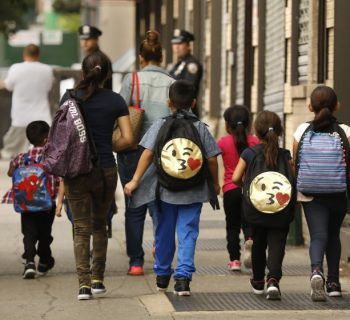By Lauren Villagran | USA Today | MAY 26, 2023 | Photo by Gaby Velasquez
A Homeland Security promotional video shows Honduran men, chained at the waist and handcuffed, boarding stairs to a plane with the Franklin Mountains as a backdrop.
Inside a federal agent walks the aisle between seats packed with dark-haired men. The video is wordless but the message is clear: Migrants who cross into the United States illegally will be sent back.
Since Title 42 ended on May 12, the Biden administration has launched a public relations blitz aimed at dissuading would-be migrants from making the journey north and persuading the American public that it's enforcing the law at the border.
A transformation in border enforcement is underway as U.S. authorities return to applying the nation's immigration laws under Title 8 after ending quick, pandemic-era expulsions. The messaging suggests the administration wants to project a hard line while taking a swing at critics on the right who claim the president supports "open borders."
"They are very anxious to show that they are delivering consequences," said Adam Isacson, who directs the Washington Office on Latin America's defense oversight program. "That Title 42’s end doesn’t mean you won't be returned. They are trying to control the narrative."
The enforcement and removal wing of Homeland Security falls under U.S. Immigration and Customs Enforcement. That agency — smaller than Border Patrol and historically unresponsive to media inquiries — has been posting news releases headlined "ICE conducts removal flights" and inviting media to witness the secretive departures.
"They never talked about this before," said Tom Cartwright, who tracks ICE flights for South Texas-based Witness at the Border. "I think it’s to show they are being strong in ‘protecting the border’ and to send a message."
The images ICE is sharing counter the visuals of recent months: long lines of men, women and children huddled under blankets, waiting to seek asylum at the border.
ICE has uploaded "B-roll," background videos like the one of the Hondurans. Another features full production: an ICE attaché speaking to the camera alongside her silent Guatemalan counterpart while a deportation flight deplanes on a Guatemalan air force base.
Homeland Security Sec. Alejandro Mayorkas has promoted the administration's creation of new, lawful pathways for people wishing to seek asylum at the U.S. border, including via the CBP cellphone app, and has said the administration has "a humanitarian obligation to cut the smugglers out." But he has repeatedly warned migrants against crossing between ports of entry.
"We are building lawful pathways for people to come to the United States without resorting to the smugglers," he said in an April press briefing. "At the same time, we are imposing consequences on those who do not use those pathways and instead irregularly migrate to our southern border."
The "consequences" include potential prosecution and removal, or deportation. But the U.S. government needs cooperation from the nations receiving the deportation flights.
The delicate nature of the negotiations that underpin the administration's new focus on removals was evident in early May, when Colombia, citing "cruel and degrading treatment" of migrants, forced the cancelation of U.S. deportation flights scheduled to return 1,200 mostly mothers and children.
"The use of restrictive elements like handcuffs at the feet and hands, including in women who are mothers, has been one of the central aspects of the negotiations between agencies," said Fernando García Manosalva, director-general of Colombia's immigration agency.
Flights to Colombia were restarted the following week on U.S. promises of roundtable discussions to protect human rights. The handcuffs continue to appear in ICE promotional videos; one video filmed in South Texas showed women and children boarding a plane freely, without restraints.
Cartwright said the ICE promotional videos are designed to "shame and scare people."
"Before, there were a lot of things that were happening that bordered on the old Trump policies," he said. "In this PR campaign particularly, it’s clear to me that they are now following the same playbook. They have turned the corner now from cruelty as a byproduct of policy to cruelty being the point of the policy."
ICE flights around the globe
When the Biden administration ended the national COVID-19 emergency on May 12, the Title 42 expulsions ended with it. Border authorities, including ICE, returned to applying the nation's immigration laws under Title 8.
Title 8 includes the asylum process, as well mechanisms for removing migrants who don't qualify for immigration relief through voluntary returns, expedited removals and formal deportations. The Biden administration has said anyone returned under expedited removal will face a 5-year ban on entering the country.
ICE is playing a bigger role in the administration's messaging, although it's been behind the scenes all along. The agency's non-detained docket — the number of people who aren't detained but have pending removal orders — has swelled to nearly 4.8 million people in fiscal 2022 from 3.7 million in fiscal 2021, according to its latest annual report.
With 6,000 law enforcement agents ICE is a third the size of Border Patrol, which has more than 19,000 agents.
"We are a small agency," Mary De Anda-Ybarra, director of El Paso ICE Enforcement and Removal Operations, said in a May 5 interview.
"We don't have enough officers to handle all of the work that we need to do because," she said, "we are not just taking in the individuals (who) are crossing illegally, (who) are being referred to us by CBP, but we are also responsible for our non-detained cases."
Under Biden, ICE ramped up removals in fiscal 2022 to roughly 72,000 from about 59,000 in fiscal 2021.
The pace is far off that of the Trump administration during its last year, when the agency recorded nearly 186,000 removals in fiscal 2020 amid a global pandemic. That number was lower than the more than 267,000 removals the prior fiscal year.
In practice, the Biden administration leaned heavily on Title 42 expulsions, quickly returning migrants more than 1 million times each in fiscal years 2021 and 2022, often to Mexico. It's not clear whether the administration's PR campaign will be followed by an increase in removal flights to countries across the globe.
ICE didn't respond to a request for information.
The agency's May news releases advertise removal flights to Guatemala, Honduras, Brazil, Colombia, El Salvador and Israel but don't provide the number of migrants removed or the number of flights logged.
A Homeland Security spokeswoman said the number of people removed under Title 8 would "be available in the coming days" and provided a statement:
"During the past two weeks, DHS has repatriated thousands of noncitizens, dramatically increased expedited removal processing in CBP and ICE facilities, and expanded access to safe and orderly processes," she said.
But Cartwright, who tracks ICE flights, reports ICE removal flights declined slightly in May, to an average of fewer than four flights per day from nearly six per day in recent months.
That's in part because the number of people arriving at the U.S.-Mexico border has plummeted since the end of Title 42 as migrants — and smugglers — wait to see what's what. The processing of migrants under Title 8 also takes more time, meaning any increase in expedited removals may not be visible for a few weeks' times.
In El Paso, Border Patrol is releasing far fewer migrants with notices to appear in immigration court, although it's not clear whether the drop is entirely because of the decline in migrant encounters or if more people are being detained before being removed or deported.
CBP in El Paso released nearly 4,300 people the week Title 42 ended, according to a city online dashboard. The following week the number dropped by 1,000 to roughly 3,300. Last week, CBP reported releasing fewer than 700 people.
'You will be sent home'
The Biden administration isn't only targeting its messaging to migrants but to the nonprofits that work with them, said Vanessa Dojaquez-Torres, policy counsel for HIAS, a New York-based migrant aid organization that works El Paso and Juárez.
The Department of Homeland Security has stated that they have started a new international messaging campaign, and they're trying to get NGOs to help spread the messages," she said. "One of the obstacles that needs to be addressed, if we want to progress in a positive way, is getting back to root causes. There is a fundamental misunderstanding of why people want to travel here."
Addressing the "root causes" of migration including pervasive violence, political upheaval and climate change was an early focus of the Biden administration. That work is long-term; the PR campaign appears to be focused on reducing irregular crossings at the Southwest border now.
In one of the ICE videos, Lupita Serna, the agency's regional attaché for Central America, warns people — in English — not to make the journey to the U.S. border.
“We are increasing our ICE personnel at the border," she said. "Don’t make a trip in vain. Don’t risk your life. Like the people on this plane, you will be sent home.”







